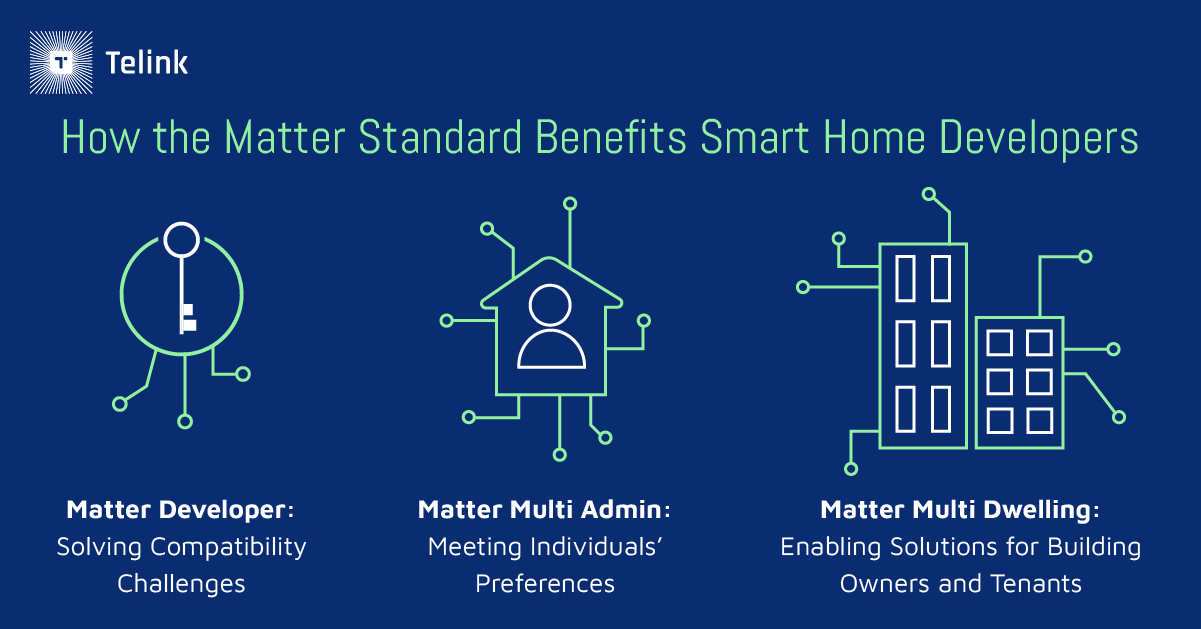



PLEASE ROTATE ME


Telink Staff
June 29, 2021
Standards

With Matter increasing compatibility between devices, developing a smart home network has never been easier.
Established in 2002, Zigbee Alliance was formed by global device manufacturers coming together to transform the foundation and future of the Internet of Things (IoT). In 2019, the Alliance created Project Connected Home over IP (Project CHIP) with the goal of building a universal standard that would enable interoperability in smart home devices.
Recently, Zigbee Alliance rebranded as Connectivity Standards Alliance (CSA), and Project CHIP was given a new name — Matter.
Made up of more than 350 device manufacturers around the world, including giants like Apple, Amazon, Google, and Samsung, CSA continues its goal of simplifying device design and development while increasing compatibility for consumers. Because Matter supports Alexa, Google Assistant, and Siri, as well as Ethernet, WiFi, Thread, and Bluetooth® Low Energy, smart home developers can more easily design products that offer maximum flexibility and functionality for consumers. End-users can simply buy a Matter-enabled device, connect it to their home network, and use it with the voice assistant of their choice in conjunction with their other smart home appliances.
Even before Project CHIP, the smart home market was already enjoying fast growth. One report projects an 11.6 percent compound annual growth between 2020 and 2025, with a jump in value from $78.3 billion to $135.3 billion during that period. With Matter’s launch, these numbers are only expected to increase. Matter’s revolutionary benefits could very well pave a new future for the IoT, by extending accessibility, solving particular developer challenges, and even opening up new use cases.

When smart home ecosystems were first gaining traction, different manufacturers offered a range of exciting but often proprietary devices. While the influx of options was great in theory for consumers, the reality was that making sure different devices could communicate with each other in a home network proved to be cumbersome.
During the manufacturing process, developers had to take extra steps to ensure devices were compatible with different ecosystems and evolved to meet updated standards. In addition, because most interfaces are through the cloud, developers also had to provide cloud, app, account, and other infrastructures to make those connections.
With Matter, developers now have an easier time building smart home devices that work with all major ecosystems. Local connectivity is enabled without total reliance on the cloud or apps.
Because Matter is based on open-source implementation, with market-proven technologies that leverage best practices in user experience and security, developers have access to drop-in code and development tools that are tested, validated, and supported by members of the Alliance. With lower costs and accelerated time to market, developers using Matter can put their focus on creating products with value.
As mentioned earlier, choosing the right IoT device can be challenging when there is not an immediate guarantee that it will work seamlessly with an existing smart home ecosystem. Consumers want to be able to add new devices to their network without onerous compatibility tests. Matter delivers its promise of user choice and interoperability with Multi Admin.
A foundational feature in Matter, Multi Admin enables users to connect their Matter devices to their other devices and ecosystems locally, securely, and even simultaneously. Different members of the same household can control which devices they share on which systems, all on an individual level. With Multi Admin, users have the freedom to choose the brands and devices that they love while creating unique experiences on their preferred ecosystems, all with the satisfaction of knowing that their smart home will be able to evolve as needed.
When it comes to commercial and residential real estate, building owners have hesitated to invest in smart home features that could add value to their properties. What if new tenants already own or prefer devices that do not work with the building’s underlying ecosystem? Starting over and finding workarounds could be costly and unappealing for both parties. Matter alleviates that challenge by enabling builders and real estate developers to select from a wide range of popular smart home brands and products that will work with whatever ecosystems and apps that their tenants may have.
As a building block for connected systems, Matter can also help building managers operate highly efficient buildings and reduce overhead, by offering real-time visibility into critical data. Because Matter devices run on local IP networks, integrating with existing IP-based facility management applications becomes effortless, even at the scale of a high-rise building. This provides a comfortable and secure environment for not only the tenants but also the building owners and property managers.
As a member of the Connectivity Standards Alliance, Telink is excited to be a part of this ambitious collaboration to bring a more powerful, more interoperable IoT standard to developers and consumers alike.
Visit our wiki to learn more about all our development tools, or ask us a question through our Technical Forum or by contacting us directly today.